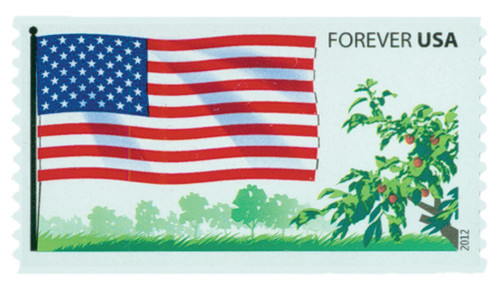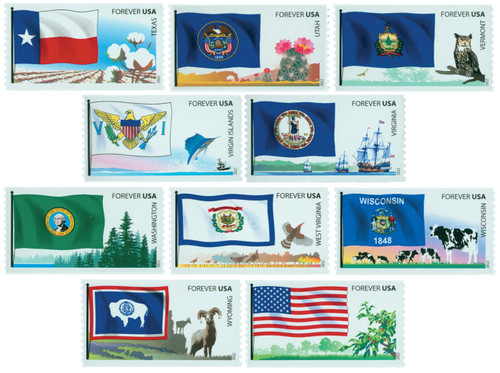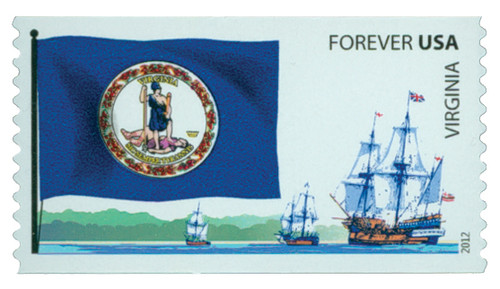
# 4332 - 2012 First-Class Forever Stamp - Flags of Our Nation: US Flag
U.S. #4332
2012 45¢ Fruited Plains
Flags of Our NationÂ
Â
Issue Date: August 16, 2012
City: Sacramento, CA
Quantity: 25,000,000
Printed By: American Packaging Corp for Sennett Security Products
Printing Method: Photogravure
Color: Multicolored
Â
Flags of Our Nation, Set VI: 2012 marks the sixth and final set of stamps in the series. The state and territory flags reflect the history of each region they represent. The uniqueness of each state flag in the series reflects the diversity of the United States and its territories. Â
Â
Katherine Lee Bates stood atop Pikes Peak in 1893 and was inspired to write a poem she called “America.â€Â Over a decade later, her poem was paired with the music of Samuel Ward and became the popular song “America the Beautiful.†Â
Â
Some have suggested it should be our country’s national anthem, but The Star-Spangled Banner continues to hold that place of honor. “America the Beautiful†describes the wonders of our vast and diverse nation and has been sung by world-renowned artists over the years.
Â
Segregation was still common in the U.S. in the 1930s. African-American opera singer Marian Anderson had found great success in Europe, and her talent was beginning to be recognized in the U.S. When she was forbidden to sing in Constitution Hall, owned by the Daughters of the American Revolution, President Franklin Roosevelt and DAR member and First Lady Eleanor arranged an open-air concert on the steps of the Lincoln Memorial. On Easter Sunday, April 9, 1939, Anderson stirred the hearts of over 75,000 people when she sang “America the Beautiful.â€Â Radio listeners in “alabaster cities†and across “the fruited plains†shared in that historic moment.
Â
On November 4, 1979, Islamic militants seized the American embassy in Tehran, taking hostages. The crisis lasted for over a year, drawing worldwide attention, and playing a significant role in the 1980 presidential election. In 1978 riots, demonstrations, and strikes erupted in protest of Iran’s Shah Mohammed Reza Pahlavi’s regime. The shah had been an important ally of the US since 1953, when the CIA and MI6 backed a coup to help him regain power. He purchased billions of dollars in arms, and supplied the US with oil imports. The Carter administration saw the shah as a source of embarrassment, as his regime used secret police, torture, and harsh punishment. An exiled Iranian Islamic leader, the Ayatollah Khomeini, was orchestrating a revolutionary campaign to overthrow the Shah. Khomeini openly regarded the US as an enemy, and vowed to cut off oil exports if he gained control of Iran. However, through secret talks, Carter’s administration believed agreement could be reached. So, when the uprising peaked in January 1979 and it was clear that the shah was deeply unpopular, the Carter administration advised the shah not to fight, but to flee. The shah fled to Egypt and then to Mexico. Carter persuaded him not to come to the US so that Khomeini would not cut off the oil supply. Hundreds of the Shah’s officials and military officers were executed when Khomeini took power. Thousands of US workers in the country were permitted to leave, but militant forces attacked the US embassy on February 14, 1979, holding the ambassador and about 100 Americans for about two hours until they were rescued by Khomeini’s troops. Iran continued supplying 700,000 barrels of oil a day to the US. The shah, who had been diagnosed with cancer, sought permission to seek medical attention in the US. President Carter, despite warnings that aiding the shah would bring serious repercussions from Iran, was convinced by Henry Kissinger and billionaire banker David Rockefeller, both personal friends of the shah, to grant him entry. When the shah arrived in the US on October 23, militant Iranians surrounded the US embassy chanting “Death to Carter†and “Death for the Shah.â€Â On November 4, mobs stormed the embassy capturing most of its personnel and visitors. These hostages were paraded through the streets blindfolded – their lives threatened unless the Shah and his wealth returned to Iran. US envoys sent to negotiate were turned away. On the 12th of November Carter banned the purchase of Iranian oil, and froze Iranian assets in the US worth approximately $6 billion. To maintain diplomatic relations, the bank accounts of the Iranian embassy and its consulates were not touched. To appeal to minority activists, Khomeini released a group of hostages on November 19 and 20 that included eight blacks and five women. To appease Iran, the shah was persuaded to leave the US. He went to Panama, and then, facing extradition, went to Egypt. He died there of lymphatic cancer four months later. Six embassy employees escaped from Iran on January 20, 1980, after being hidden by Canadian diplomats, and one hostage was permitted to leave due to health reasons on July 11, 1980. Fifty-two hostages remained in captivity. At first the American people rallied behind Carter, but soon there were feelings of humiliation and anger. In desperation Carter ordered that a secret military mission be carried out to rescue the hostages; however, it went poorly. On April 25 the president addressed the nation with news that this mission had been aborted after three out of eight helicopters had failed mechanically. In retreat, a helicopter and transport plane collided killing eight servicemen and injuring others. Only two days before the presidential elections, Iran announced its stiff terms for releasing the hostages – the timing was designed to affect voting. Election day, November 4, would mark a full year of captivity for the hostages. Serious negotiations began only after Carter’s electoral defeat. Although Carter agreed to most of Iran’s conditions, the Iranians stalled over minor points. Delaying tactics persisted until after Carter’s term had ended. The release of the hostages coincided with the swearing in of President Ronald Reagan. He warned, “Let terrorists be aware that when the rules of international behavior are violated, our policy will be one of swift and effective retribution.â€Â Former President Jimmy Carter flew to Germany to greet the hostages. In all, the hostages had spent 444 days in captivity.Iranian Hostage Crisis



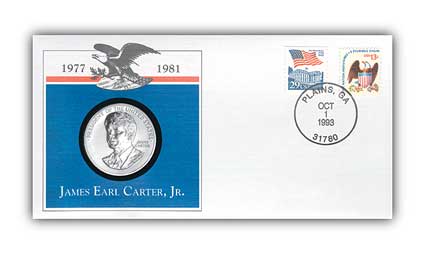
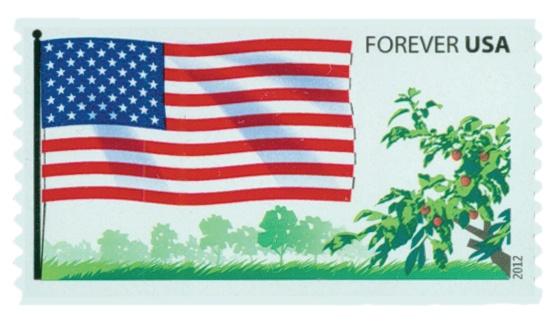
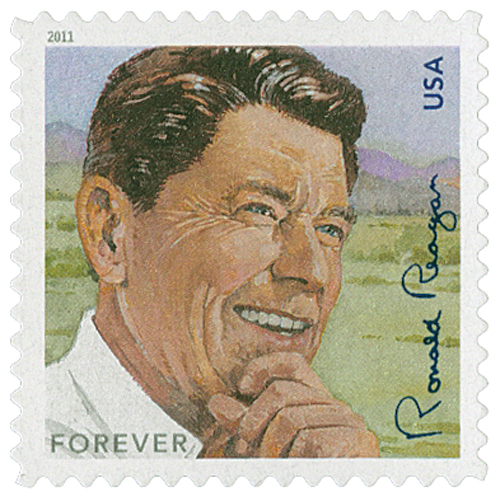

U.S. #4332
2012 45¢ Fruited Plains
Flags of Our NationÂ
Â
Issue Date: August 16, 2012
City: Sacramento, CA
Quantity: 25,000,000
Printed By: American Packaging Corp for Sennett Security Products
Printing Method: Photogravure
Color: Multicolored
Â
Flags of Our Nation, Set VI: 2012 marks the sixth and final set of stamps in the series. The state and territory flags reflect the history of each region they represent. The uniqueness of each state flag in the series reflects the diversity of the United States and its territories. Â
Â
Katherine Lee Bates stood atop Pikes Peak in 1893 and was inspired to write a poem she called “America.â€Â Over a decade later, her poem was paired with the music of Samuel Ward and became the popular song “America the Beautiful.†Â
Â
Some have suggested it should be our country’s national anthem, but The Star-Spangled Banner continues to hold that place of honor. “America the Beautiful†describes the wonders of our vast and diverse nation and has been sung by world-renowned artists over the years.
Â
Segregation was still common in the U.S. in the 1930s. African-American opera singer Marian Anderson had found great success in Europe, and her talent was beginning to be recognized in the U.S. When she was forbidden to sing in Constitution Hall, owned by the Daughters of the American Revolution, President Franklin Roosevelt and DAR member and First Lady Eleanor arranged an open-air concert on the steps of the Lincoln Memorial. On Easter Sunday, April 9, 1939, Anderson stirred the hearts of over 75,000 people when she sang “America the Beautiful.â€Â Radio listeners in “alabaster cities†and across “the fruited plains†shared in that historic moment.
Â
On November 4, 1979, Islamic militants seized the American embassy in Tehran, taking hostages. The crisis lasted for over a year, drawing worldwide attention, and playing a significant role in the 1980 presidential election. In 1978 riots, demonstrations, and strikes erupted in protest of Iran’s Shah Mohammed Reza Pahlavi’s regime. The shah had been an important ally of the US since 1953, when the CIA and MI6 backed a coup to help him regain power. He purchased billions of dollars in arms, and supplied the US with oil imports. The Carter administration saw the shah as a source of embarrassment, as his regime used secret police, torture, and harsh punishment. An exiled Iranian Islamic leader, the Ayatollah Khomeini, was orchestrating a revolutionary campaign to overthrow the Shah. Khomeini openly regarded the US as an enemy, and vowed to cut off oil exports if he gained control of Iran. However, through secret talks, Carter’s administration believed agreement could be reached. So, when the uprising peaked in January 1979 and it was clear that the shah was deeply unpopular, the Carter administration advised the shah not to fight, but to flee. The shah fled to Egypt and then to Mexico. Carter persuaded him not to come to the US so that Khomeini would not cut off the oil supply. Hundreds of the Shah’s officials and military officers were executed when Khomeini took power. Thousands of US workers in the country were permitted to leave, but militant forces attacked the US embassy on February 14, 1979, holding the ambassador and about 100 Americans for about two hours until they were rescued by Khomeini’s troops. Iran continued supplying 700,000 barrels of oil a day to the US. The shah, who had been diagnosed with cancer, sought permission to seek medical attention in the US. President Carter, despite warnings that aiding the shah would bring serious repercussions from Iran, was convinced by Henry Kissinger and billionaire banker David Rockefeller, both personal friends of the shah, to grant him entry. When the shah arrived in the US on October 23, militant Iranians surrounded the US embassy chanting “Death to Carter†and “Death for the Shah.â€Â On November 4, mobs stormed the embassy capturing most of its personnel and visitors. These hostages were paraded through the streets blindfolded – their lives threatened unless the Shah and his wealth returned to Iran. US envoys sent to negotiate were turned away. On the 12th of November Carter banned the purchase of Iranian oil, and froze Iranian assets in the US worth approximately $6 billion. To maintain diplomatic relations, the bank accounts of the Iranian embassy and its consulates were not touched. To appeal to minority activists, Khomeini released a group of hostages on November 19 and 20 that included eight blacks and five women. To appease Iran, the shah was persuaded to leave the US. He went to Panama, and then, facing extradition, went to Egypt. He died there of lymphatic cancer four months later. Six embassy employees escaped from Iran on January 20, 1980, after being hidden by Canadian diplomats, and one hostage was permitted to leave due to health reasons on July 11, 1980. Fifty-two hostages remained in captivity. At first the American people rallied behind Carter, but soon there were feelings of humiliation and anger. In desperation Carter ordered that a secret military mission be carried out to rescue the hostages; however, it went poorly. On April 25 the president addressed the nation with news that this mission had been aborted after three out of eight helicopters had failed mechanically. In retreat, a helicopter and transport plane collided killing eight servicemen and injuring others. Only two days before the presidential elections, Iran announced its stiff terms for releasing the hostages – the timing was designed to affect voting. Election day, November 4, would mark a full year of captivity for the hostages. Serious negotiations began only after Carter’s electoral defeat. Although Carter agreed to most of Iran’s conditions, the Iranians stalled over minor points. Delaying tactics persisted until after Carter’s term had ended. The release of the hostages coincided with the swearing in of President Ronald Reagan. He warned, “Let terrorists be aware that when the rules of international behavior are violated, our policy will be one of swift and effective retribution.â€Â Former President Jimmy Carter flew to Germany to greet the hostages. In all, the hostages had spent 444 days in captivity.Iranian Hostage Crisis








